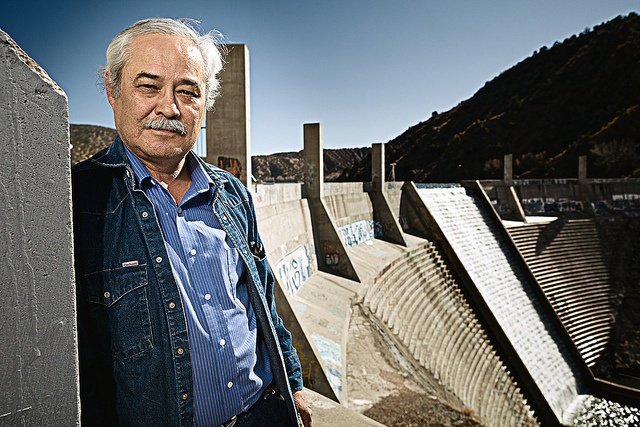Reseachers recommend solutions for sediment trapping in irrigation system

Kenny Salazar, owner of Kenny Salazar Orchards, stands beside the Santa Cruz Reservoir Dam, which holds back the waters of the Santa Cruz Irrigation District. Salazar, a board member with the district, with help from the Lab’s NMSBA program and Sandia National Laboratories is looking for ways to reduce sediment build up and increase capacity in the reservoir to help farmers.
Contact
- Kurt Steinhaus
- Community Programs Office
- (505) 665-7370
Sediment buildup in irrigation researched by Small Business Association joint LANL, SNL expertise
Perched above the Española Valley, the Santa Cruz reservoir overlooks more than 1,600 farms that depend on its water. Over the years, sedimentation has reduced the reservoir’s capacity by 36%. Kenny Salazar, owner of Kenny Salazar Orchards and Santa Cruz Irrigation District (SCID) Board Chairman, is one of those farmers. In dry years, the SCID is forced to ration its water and shorten the growing season, affecting commercial farmers like Salazar, who have used the water to irrigate their fields for generations.
A multi-million dollar project is planned to raise the height of the dam and recover part of the lost storage, but any storage gains will be lost within 15 to 20 years if the sediment is not managed.
Through a joint NMSBA project, LANL and SNL leveraged their technical expertise to determine the sources of sediment and recommend solutions for its management.
LANL project lead Robert Roback, SNL co-lead Jesse Roberts, and their team found that a significant amount of sediment comes from the arroyos feeding Santa Cruz Lake, with less sediment originating from the main stem of the Santa Cruz River. This finding prevented SCID and the small businesses it represents and supports—from building a large and expensive sediment trap in the wrong location. The SCID is now pursuing plans to build smaller, lower-cost traps in the arroyos, optimizing sediment capture while minimizing expense to affected businesses.














